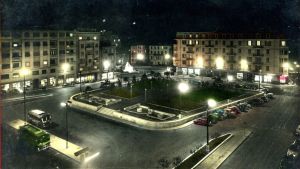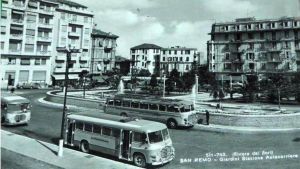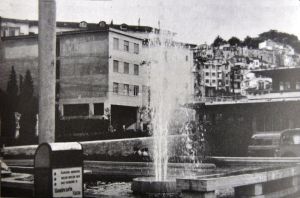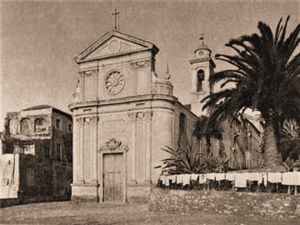Water distribution in Sanremo
(edited by Roberto Monfroni)
The fountains
The history of the fountains of Sanremo starts from the opening of the first Aqueduct in 1828 wanted by the then mayor Siro Andrea Carli.
Before that time there were few sources from which to get water, both for drinking and for the irrigation of the gardens.
This aqueduct allowed the construction of four fountains, scattered in the most strategic points of the city.
The other fountains came later, as described in the dedicated chapter. (to learn more click here)
The fountain in Piazza dei Dolori
The fountain is one of the first four to benefit from the water coming from Mayor Siro Andrea Carli's aqueduct.
Below is a personal testimony by Giacomo Mannisi (a scholar of Sanremo history) which also describes its history well:
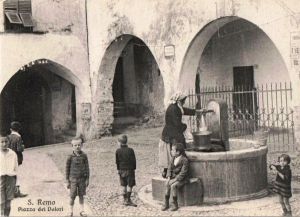 « I turn and turn in my hands an old postcard of Sanremo, the caption reads "Sanremo as it was" it is the photograph of Piazza dei Dolori, formerly dedicated to San Sebastiano, one of those black and white photos that take you back to the past years when everything had another flavour and looked more beautiful.
« I turn and turn in my hands an old postcard of Sanremo, the caption reads "Sanremo as it was" it is the photograph of Piazza dei Dolori, formerly dedicated to San Sebastiano, one of those black and white photos that take you back to the past years when everything had another flavour and looked more beautiful.
The square is certainly one of the most beautiful and characteristic of Sanremo, I remember when I was a kid, in the first television dramas the squares of the small villages were represented just like that.
In the middle there was a fountain where the women went to get water and stopped to make ciapeti with the other housewives, all around there were three or four storey high buildings that did not prevent the sun rays from filtering and warming the days of the children, who could play quietly because there were no cars or other dangers, At a certain time of day, their mothers would call them to come home from the same windows that they also used to spy on passers-by or neighbours who, in the case of strange situations, became the subject of chatter when they met at the wash-house or in the churchyard on Sunday mornings after mass. 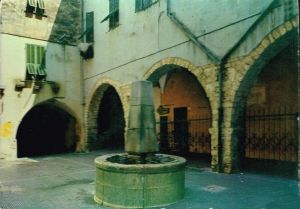 The fountain in the photograph, however, is not as I remember it from the early 1960s when, as a child of about four or five, I was taken to Sanremo, which from then on became my adopted city; I remember a sort of well with a small pinkish-white stone obelisk in the centre.
The fountain in the photograph, however, is not as I remember it from the early 1960s when, as a child of about four or five, I was taken to Sanremo, which from then on became my adopted city; I remember a sort of well with a small pinkish-white stone obelisk in the centre.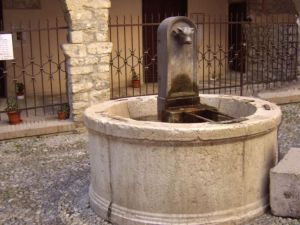 Today, however, the fountain in Piazza dei Dolori is again as depicted in the postcard that I jealously hold in my hands. The well is still the same, but in the centre, instead of the obelisk, there is a cast iron casting with a bull's head, which to tell the truth has very little to do with the bull, and from which a small continuous jet of water comes out.
Today, however, the fountain in Piazza dei Dolori is again as depicted in the postcard that I jealously hold in my hands. The well is still the same, but in the centre, instead of the obelisk, there is a cast iron casting with a bull's head, which to tell the truth has very little to do with the bull, and from which a small continuous jet of water comes out.
The current arrangement took place in the 1990s, when, as the square was being rebuilt to repair the sewage pipes and reposition the cobblestones, with the passageway marked in the middle by red bricks, with the intention of restoring the square to its former glory, the people in charge of the work decided to contact the Turin factory which, as luck would have it, still had the mould for casting the central part of the fountain in cast iron, and they had a copy cast especially for them, which they placed on site with the pride of those who thought they were doing a worthy job.
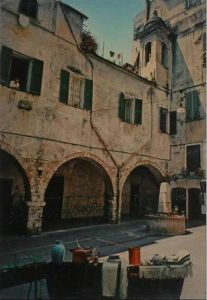 When the work was finished, however, instead of receiving expressions of gratitude, they were strongly contested by those who knew perfectly well that the fountain in the photo was not the one originally designed, but a remake due to the desire to pay homage to the Savoy family, who, as lords of Turin, had seen the Genoese Republic, including San Remo, assigned to the Kingdom of Sardinia in 1815 (Congress of Vienna).
When the work was finished, however, instead of receiving expressions of gratitude, they were strongly contested by those who knew perfectly well that the fountain in the photo was not the one originally designed, but a remake due to the desire to pay homage to the Savoy family, who, as lords of Turin, had seen the Genoese Republic, including San Remo, assigned to the Kingdom of Sardinia in 1815 (Congress of Vienna).
Unfortunately, when they wanted to redo the fountain as shown in the photo, they didn't take into account that obelisks are a sort of trademark for Sanremo, since it tells the legend of Captain Bresca who, at the risk of his own life, contributed in a decisive way to the erection of the obelisk of Saint Peter's Square in Rome in 1586 and of which the people of Sanremo are extremely proud.
When in 1828 the mayor of Sanremo Siro Andrea Carli, Carlandria for the people of Sanremo, decided that it was time for his city to have a water supply system that would allow a standard of living more in line with the needs of his time, he decided to build an aqueduct that, bringing water from Lake Negro, under the slopes of Mount Bignone, would flow into the four most important city squares through fountains designed for the occasion.
The squares were: Piazza Santo Stefano (today known as Piazza Nota), overlooked by the former town hall; Piazza del Mercato, the place where the citizens met par excellence; and Piazza dei Dolori.
Later, the one in Piazza Bresca was built, the one that connected the city to the sea, and in memory of Captain Benedetto Bresca, was placed the stele most similar to the obelisk of St. Peter, but also Piazza Nota has a central pillar, Piazza del Mercato, today Piazza Eroi Sanremesi, had a stone, on which was later placed the statue of Carlandria, this assumes that even Piazza dei Dolori, although there are no documentary evidence, had in the centre of the pool something similar to an obelisk.
Probably at the end of the 19th century the original fountain was replaced by the 'bull' immortalised in the postcard; in the first half of the 20th century there was a new replacement with the obelisk that I still remember, which, if it was not the original, is as close as one can get to it; and finally in the 1990s the last replacement with the bull's head that we can still see today.
At this point, all that remains is to wonder what happened to the small pinkish-white stone obelisk that I remember; anyone wishing to take a walk to the Hermitage of St Michael could easily see it in the middle of a strip of road, a few dozen metres before the little church, standing looking down on a city that, without a hint of gratitude, has abandoned it ».
The fountain in Piazza Santo Stefano (or Piazza Palazzo)
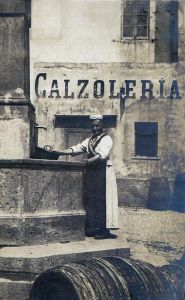
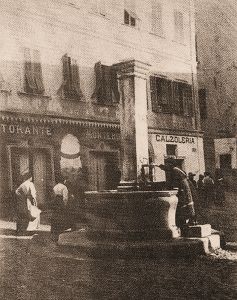 The fountain in the square now named after Alberto Nota, where the former Town Hall stands (built around 1750), is another of the first four built
The fountain in the square now named after Alberto Nota, where the former Town Hall stands (built around 1750), is another of the first four built 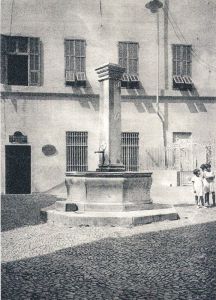 after the arrival of the Cali Aqueduct.
after the arrival of the Cali Aqueduct.
The fountain has always remained the same, in the same place, despite the fact that history has repeatedly changed the scenery around it. 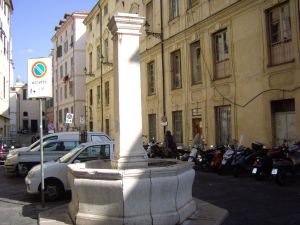
The paving of the square was cobbled until 1936 when the municipality decided to replace it with stone slabs.
It too has a small obelisk in the centre, which, as Mannisi said, remains a constant symbol for the city.
The Market Fountain
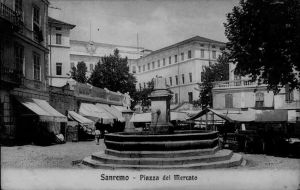 It was opened between 1827 and 1831 to a design by civil engineer Gio Luigi Clerico and its location was described at the time as "in a steep area behind
It was opened between 1827 and 1831 to a design by civil engineer Gio Luigi Clerico and its location was described at the time as "in a steep area behind 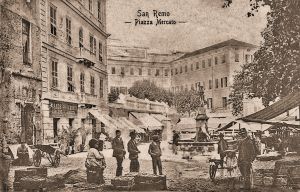 the apse of the church of San Siro and bordering the right bank of the Vallotto or San Romolo stream (today part of Piazza Eroi Sanremesi)".
the apse of the church of San Siro and bordering the right bank of the Vallotto or San Romolo stream (today part of Piazza Eroi Sanremesi)".
This fourth fountain, created almost at the same time as the other three, was the centre of town life for decades.
Like the others, it always remained in the same place and was born with a square base in the centre, which had four fonanelle at the sides and was surmounted by a truncated capital on which in one of the pictures you can see a little boy, in an evident state of precarious equilibrium.
In fact, when life moved from the old town, la Pigna, to the Piano (u Ciàn), with the increase in the number of its residential buildings, its hotels and the advent and growth of 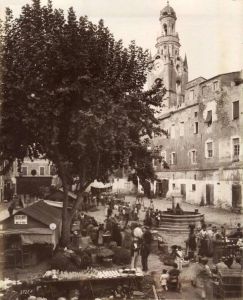
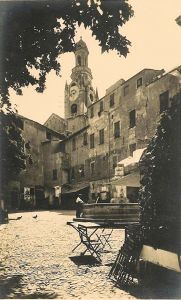 Tourism, the fountain became the only central point from which to draw the water necessary for the town's daily life.
Tourism, the fountain became the only central point from which to draw the water necessary for the town's daily life.
After its construction, a Convent was converted into a Public School in the vicinity, the San Romolo stream was covered over, creating a large square which, from Piazza del Mercato, in 1917 became Piazza Eroi Sanremesi, practically occupying the town centre.
There was a lot of activity around it because the open-air market took place nearby, there were many shops in buildings that no longer exist, stalls with goods for sale, but above all flower stalls that over time became fixed kiosks, recently eliminated with the revaluation of that part of the square, right around the fountain.
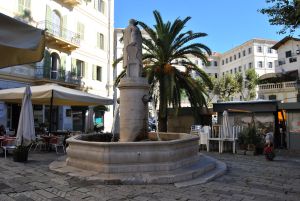 In the early 1960s, the monument with the statue of Siro Andrea Carli, familiarly called "Carlandria" by the people of Sanremo, after wandering around various places in the square, but mainly in front of the schools, was placed in the centre of the fountain, in place of the square base with the capital that
In the early 1960s, the monument with the statue of Siro Andrea Carli, familiarly called "Carlandria" by the people of Sanremo, after wandering around various places in the square, but mainly in front of the schools, was placed in the centre of the fountain, in place of the square base with the capital that 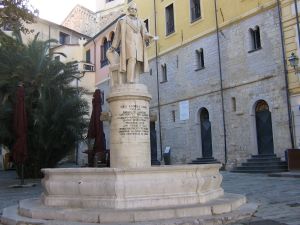 was there before.
was there before.
Since then, especially after the latest redevelopment of the square, the fountain and its illustrious guest have been a beautiful sight, and it has become a centre of visual attraction for citizens and foreign guests.
The fountain in Piazza dei Missionari

 Piazza dei Missionari, where the fountain is located, was so called because in 1720 the Missionary Fathers of St Vincent, who had been desired by the Community at the end of the previous century, built their convent in the village of Pian di Nave, precisely in Piazza Bresca.
Piazza dei Missionari, where the fountain is located, was so called because in 1720 the Missionary Fathers of St Vincent, who had been desired by the Community at the end of the previous century, built their convent in the village of Pian di Nave, precisely in Piazza Bresca.
The fountain was built by municipal resolution on 18 August 1834 on the site where it still stands, in order to meet the increasingly pressing water needs of the densely populated Marina district.
The name was changed to Piazza Bresca on 28th November 1870 by a resolution of the City Council, taking its name from the famous captain who in 1586 allowed the erection of the famous obelisk in St Peter's Square in Rome. So much so that, recalling his feat, an obelisk was erected in the centre of the fountain itself to a design by engineer Giordano of the Civil Engineers.
So much so that, recalling his feat, an obelisk was erected in the centre of the fountain itself to a design by engineer Giordano of the Civil Engineers. Consisting of a stone pyramid-shaped staircase on which an obelisk with four small fountains at its base rises, it still gives a monumental touch to the simple square bordered by sober buildings.
Consisting of a stone pyramid-shaped staircase on which an obelisk with four small fountains at its base rises, it still gives a monumental touch to the simple square bordered by sober buildings.
 Today, thanks to the fountain and the square, which have recently been restored, together with the houses around it, and the numerous restaurants that remind us that this was once the fish market, it is an attraction for the local and foreign population.
Today, thanks to the fountain and the square, which have recently been restored, together with the houses around it, and the numerous restaurants that remind us that this was once the fish market, it is an attraction for the local and foreign population.
As part of the development of this important public work, a small wall in the shape of a seat was also built in the adjacent Piazza Sardi to allow the public to watch the "ball game", traditionally played by the people of Sanremo in that square.
The fountain in Piazza del Capitolo
This fountain is already no longer part of the first four. Its history has not changed over time, and the buildings around it are still the same. 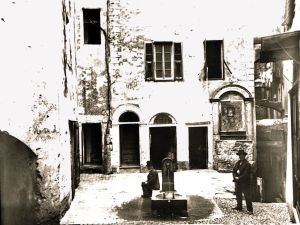
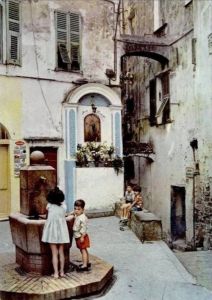
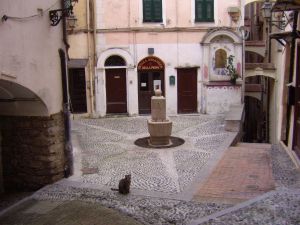 As can be seen from the pictures, this fountain too, although smaller than the others, features the classic pseudo-obelisk.
As can be seen from the pictures, this fountain too, although smaller than the others, features the classic pseudo-obelisk.
The recent restoration of the Piazza Capitolo has given it back its true appearance.
The Fountain "Funtanassa"
To talk about this fountain, we need to go back a long way, to 979 A.D., when a group of peasants, after the threat of the Saracens had ended and they had taken refuge in the 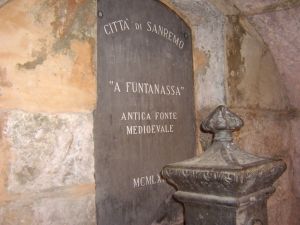 hinterland, asked and obtained permission from Bishop Teodolfo to settle on the Pliocene hill known as "Costa" in exchange for a percentage of the agricultural produce they would receive.
hinterland, asked and obtained permission from Bishop Teodolfo to settle on the Pliocene hill known as "Costa" in exchange for a percentage of the agricultural produce they would receive. 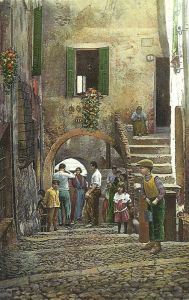 Here they began to build houses around a fortified nucleus: the 'Castrum'. The hill was easily defensible and the houses, built one next to the other without interruption, formed real walls in which there were gates at strategic points for access to and from the city.
Here they began to build houses around a fortified nucleus: the 'Castrum'. The hill was easily defensible and the houses, built one next to the other without interruption, formed real walls in which there were gates at strategic points for access to and from the city.
The problem of water, however, arose immediately because, even though the settlement had two streams, the San Francesco to the east and the San Romolo to the west, which flowed at the bottom of the two side valleys, they remained outside the walls and could not easily be reached to draw water from them.
The solution was found either by digging wells inside the city (several water veins run underground) or by building cisterns to collect and contain the water.
Among these cisterns, the most famous is the one located in what is now Via Romolo Moreno (formerly Via alla Costa), and called 'Funtanassa'.
Mentioned in some medieval documents, it is a tank that collects water from a small canal that runs inside the building above it. The water comes from rainwater dripping from the ground at a clay layer.
 To date the Funtanassa, there is a date engraved on the plaster inside the building that contains it: 1436.
To date the Funtanassa, there is a date engraved on the plaster inside the building that contains it: 1436.
However, given that the entire structure of the Funtanassa is within the walls completed by Robert of Anjou, King of Naples and protector of the Guelphs of San Romolo in 1321, it is reasonable to assume that the cistern predates this date.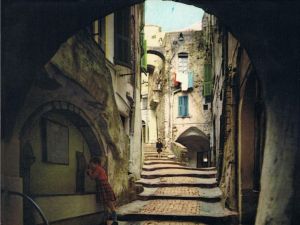 The cistern provided water both for domestic use and for watering animals, especially mules, which were used as beasts of burden.
The cistern provided water both for domestic use and for watering animals, especially mules, which were used as beasts of burden.
For this specific purpose, at the outer base of the cistern there was a basin, which we can still find depicted on some vintage postcards and which was removed around the middle of the last century, when animals were no longer used in the town. It was rectangular in shape, about 5 x 2 metres, made of large squared stone ashlars, with a barrel-vaulted roof.
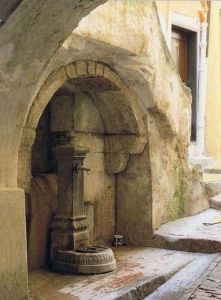 In place of the drinking trough, a small cast-iron fountain was placed, which is no longer functional.
In place of the drinking trough, a small cast-iron fountain was placed, which is no longer functional.
(For the characteristics of the internal cistern that fed the fountain see page 21 The Funtanassa cistern).
The "Zampillo" fountain
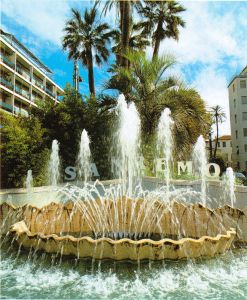 For years now, this fountain has become the symbol of Sanremo itself. When there is an important event in the city, such as the Festival della Canzone or the cycling race Milano - Sanremo or others, the first thing you see on television or in the newspapers is the fountain of the "Zampillo".
For years now, this fountain has become the symbol of Sanremo itself. When there is an important event in the city, such as the Festival della Canzone or the cycling race Milano - Sanremo or others, the first thing you see on television or in the newspapers is the fountain of the "Zampillo".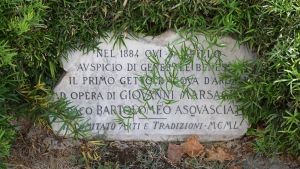 And it is no coincidence that it is called this because when, on 12 March 1884, thanks to the merits of Giovanni Marsaglia's enterprise and the well-deserving mayor Bartolomeo Asquasciati, the Aqueduct named after the builder arrived in the city, the first jet of water from the Argallo springs "gushed" at this point.
And it is no coincidence that it is called this because when, on 12 March 1884, thanks to the merits of Giovanni Marsaglia's enterprise and the well-deserving mayor Bartolomeo Asquasciati, the Aqueduct named after the builder arrived in the city, the first jet of water from the Argallo springs "gushed" at this point.
To celebrate this event, a memorial plaque was placed at the base of the fountain in 1950.
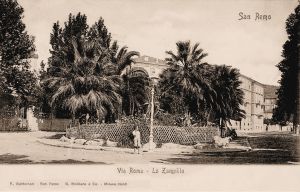
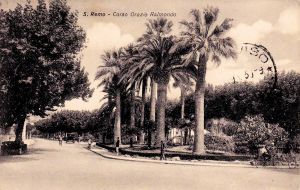 But the original fountain was certainly not like the one we see today. The place is the same, but the original was simply a small basin with a small conical point in the middle from which water gushed out, but it was important because for the first time water could be drawn outside the primordial basins and therefore closer to one's needs.
But the original fountain was certainly not like the one we see today. The place is the same, but the original was simply a small basin with a small conical point in the middle from which water gushed out, but it was important because for the first time water could be drawn outside the primordial basins and therefore closer to one's needs.
Several pictures show the green space that used to be part of Via Roma (which then began at the end of Via Fiume) and is now located at the beginning of Corso Orazio Raimondo.
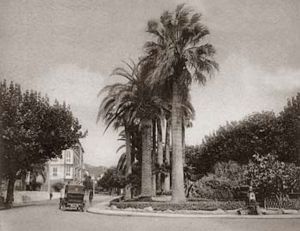 At the beginning it was just a flowerbed full of palms and agaves, as well as a common green space surrounded by a low fence and the fountain was almost invisible, but as time went by and Sanremo became an increasingly important city, they tried to improve its appearance.
At the beginning it was just a flowerbed full of palms and agaves, as well as a common green space surrounded by a low fence and the fountain was almost invisible, but as time went by and Sanremo became an increasingly important city, they tried to improve its appearance.
A small cast iron fountain, as you can see many around the city, was placed in a prominent position on the roadside, the flowerbed was better cared for, enhancing both the palms and the other plants. 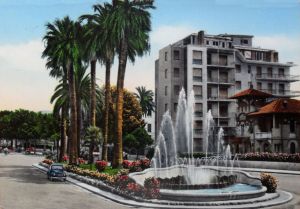 Flowering plants were added to the previously neglected grass, adding colour to the appearance of the flowerbed.
Flowering plants were added to the previously neglected grass, adding colour to the appearance of the flowerbed.
By this time the city was on the road to international tourism and the water now reached many public points and, for the wealthy, even private ones.
The "Zampillo" had lost its original function, and so it was decided to use it as an embellishment of the street furniture that was gradually taking over the entire city.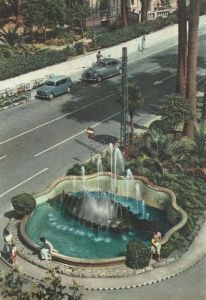 In the post-war period, while maintaining the green flowerbed, a luninous fountain was built inside a shell-shaped basin which still characterises it.
In the post-war period, while maintaining the green flowerbed, a luninous fountain was built inside a shell-shaped basin which still characterises it.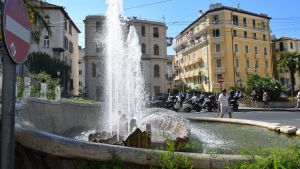
From: L'Eco della Riviera of 22nd January 1950 we read:
At the "ZAMPILLO" a luminous fountain.
« Work is going on to reorganize the Zampillo flower-bed in order to eliminate the curve that has caused so many accidents. Another fountain will be built in the flowerbed, as long as the traditional name does not become vain.
This time much larger than the previous one and luminous so as to form a magnificent backdrop to the night-time illumination of Via Roma, the work has been entrusted to a company from Milan ».
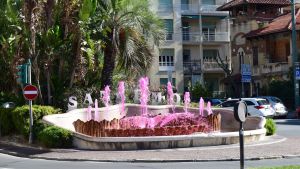 The name of Sanremo behind the fountain, highlighted in very large letters, was added later.
The name of Sanremo behind the fountain, highlighted in very large letters, was added later.
The brightness of the fountain is characterised by the possibility of varying the colour of the water, normally with successive shades, or of using a single colour on the occasion of particular events.
(free elaboration from texts by Andrea Gandolfo and other sources; images from personal archives)
The Monumental Fountain
 For years Pian di Nave, what we now know as "Giardini Vittorio Veneto", was a place full of more or less illegal constructions, numerous warehouses one next to the other, used as fishermen's warehouses, craft workshops or generally dilapidated dwellings.
For years Pian di Nave, what we now know as "Giardini Vittorio Veneto", was a place full of more or less illegal constructions, numerous warehouses one next to the other, used as fishermen's warehouses, craft workshops or generally dilapidated dwellings.
In 1936, Podestà Guidi's administration, with the aim of providing a visual outlet to the sea for the Corso Umberto I (now Corso Mombello) under construction, purchased several buildings, as well as the state-owned areas to the west of the Fortress, up to the area near the beginning of today's Lungomare Italo Calvino, and carried out a global reclamation, creating, according to plan, a large space to improve the landscape of the area. 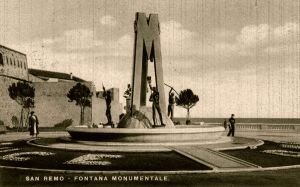 The first work was the construction of a retaining wall for the new square and consolidation work on the sea, so that it would no longer be threatened by storm surges.
The first work was the construction of a retaining wall for the new square and consolidation work on the sea, so that it would no longer be threatened by storm surges.
In addition, an environmental improvement was made with the creation of scattered flowerbeds, a variety of vegetation and even a pine forest. 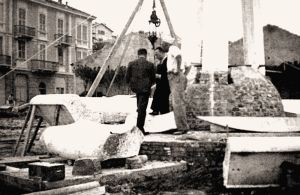 But what was most beautiful and impressive was the construction of a large and artistic monumental fountain. Also known as the "Fontana Luminosa", it stood in the centre of the square.
But what was most beautiful and impressive was the construction of a large and artistic monumental fountain. Also known as the "Fontana Luminosa", it stood in the centre of the square.
The work of the sculptor Giovanni Prini, it was built in the typical architectural style of the twenty-year period.
It is symbolised by an enormous "M" (Mussolini) in the centre of the fountain itself, surrounded by bronze statues of warriors. On either side were also 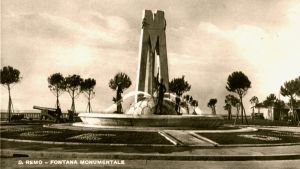 placed two of the cannons used by Admiral Pinelli to keep the city at bay when it rebelled against Genoa in 1753.
placed two of the cannons used by Admiral Pinelli to keep the city at bay when it rebelled against Genoa in 1753.
The inauguration ceremony was held on 4 November 1937 in the presence of the Hon. Tassinari, Undersecretary for Agriculture.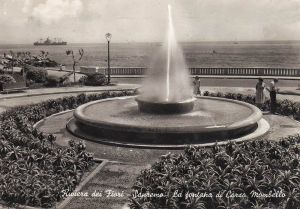 The history of this fountain was a troubled one, with continuous changes in its shape, until it disappeared altogether with the most recent restructuring of the landscape aspect of the entire square.
The history of this fountain was a troubled one, with continuous changes in its shape, until it disappeared altogether with the most recent restructuring of the landscape aspect of the entire square.
First of all, in the post-war period, in the name of reconstruction and above all to erase the legacies of the twenty years just gone, the "M" was demolished 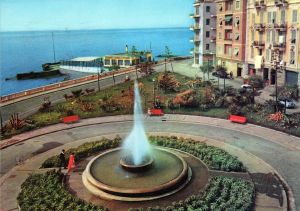 and the fountain became part of the overall reorganisation of the gardens, with flowerbeds, stony decorations, agave plants and others, and on display, alongside, the two eighteenth-century cannons recovered from the Fort in front of it.
and the fountain became part of the overall reorganisation of the gardens, with flowerbeds, stony decorations, agave plants and others, and on display, alongside, the two eighteenth-century cannons recovered from the Fort in front of it.
These pieces, after wandering here and there with different functions and for a long time even being forgotten, are now still on display at the sides of the facade of the Fort of Santa Tecla.
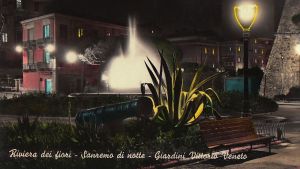
Although its appearance changed, it always remained a reference point for those who wanted to take a walk along the seafront and, above all, it remained "bright" and easily identifiable at night.
The fountain in Corso Mombello
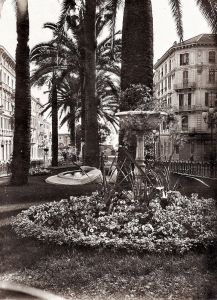 Built in a different form in the 1920s, it had a vague cloverleaf shape, the basin was made of blue majolica tiles, with four small fountains at the sides in the
Built in a different form in the 1920s, it had a vague cloverleaf shape, the basin was made of blue majolica tiles, with four small fountains at the sides in the 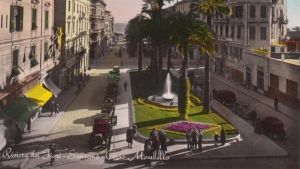 centre of the "petals" and a powerful central jet.
centre of the "petals" and a powerful central jet.
The position never changed, always at the top of Corso Umberto I° (now Corso Mombello), after the first palm tree towards Rigolet. Around the palm tree, however, the garden underwent a number of changes, although it retained a flowering lozenge for a long time.
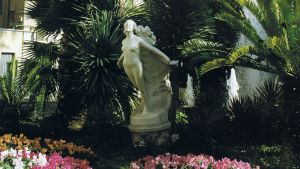 It was replaced by the statue of "Ondina" in a global makeover of the flowerbeds.
It was replaced by the statue of "Ondina" in a global makeover of the flowerbeds.
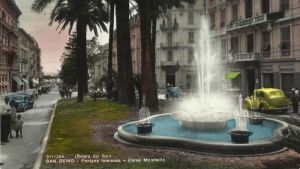 The fountains changed little, but only in the water jet.
The fountains changed little, but only in the water jet.
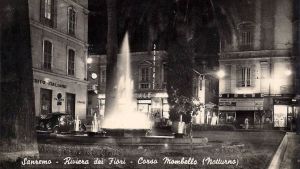 Of course it was illuminated, and in the darkness of the night, it was a landmark for locals, tourists and especially because, for several years, it was the most photographed object on the street.
Of course it was illuminated, and in the darkness of the night, it was a landmark for locals, tourists and especially because, for several years, it was the most photographed object on the street.
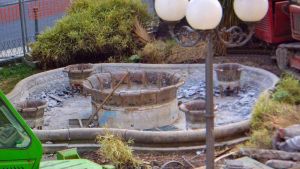 Unfortunately, due to the construction site for the spillway under the road, it was finally dismantled in 2001.
Unfortunately, due to the construction site for the spillway under the road, it was finally dismantled in 2001.
The various pieces were put aside with the idea of its reconstruction, which never took place after so many years.
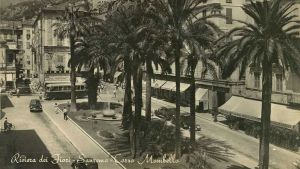 Fortunately, the memory of it remains in the many postcard images that have been taken over time.
Fortunately, the memory of it remains in the many postcard images that have been taken over time.
The fountains at the bus station
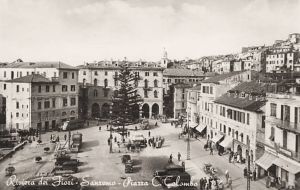 After the end of the Second World War, from 1951 onwards, the Administration continued the work of reconstructing Piazza Colombo, creating a slab on
After the end of the Second World War, from 1951 onwards, the Administration continued the work of reconstructing Piazza Colombo, creating a slab on 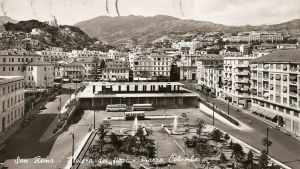 the rubble of the former Court House, which would be used as a car park for years.
the rubble of the former Court House, which would be used as a car park for years.
After the reconstruction, on 8 March 1956, after three years of work, the bus station in Piazza Colombo was inaugurated under the slab.
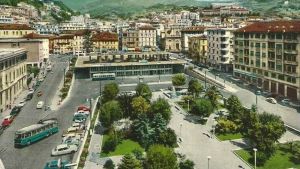 In front of it, in what had been the Flower Market, a large garden was created, with pine trees and palms, and above all with two pools with fountains which, together with the gardens, provided a relaxing view for passengers in transit.
In front of it, in what had been the Flower Market, a large garden was created, with pine trees and palms, and above all with two pools with fountains which, together with the gardens, provided a relaxing view for passengers in transit.
Both the gardens and the fountains changed their appearance several times until 1990 when, with the creation of the underground car park, which is still there today, the gardens were given a new layout and a reduced fountain also worked until the following year when it was finally removed.
(free processing from various sources and authors; web and personal images)
The fountain in Piazza Colombo
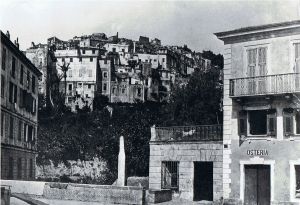
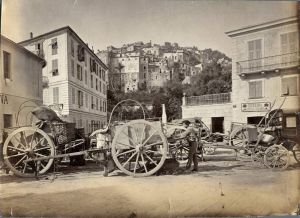 When, on the part in front of Via Palazzo, before the construction of the Minoia palace (the one with the arches), the San Francesco stream was covered over, the resulting square became a kind of car park for all kinds of animal tows, both carts and carriages.
When, on the part in front of Via Palazzo, before the construction of the Minoia palace (the one with the arches), the San Francesco stream was covered over, the resulting square became a kind of car park for all kinds of animal tows, both carts and carriages.
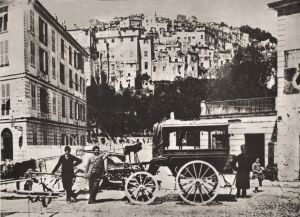 In time, it also became the terminus of the lines connecting it with neighbouring towns, and even the tramway.
In time, it also became the terminus of the lines connecting it with neighbouring towns, and even the tramway.
The term "Ciaràban" is mentioned, this being derived from the French "Car à banques", i.e. "car with benches", hence the contraction into a dialect version.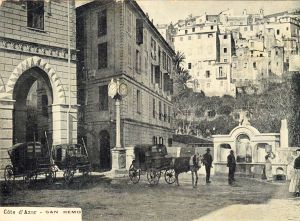 When carriages and omnibuses were pulled by horses, the Society for the Protection of Animals, whose president was Major Momber, had an animal drinking fountain built in 1899 and financed it itself.
When carriages and omnibuses were pulled by horses, the Society for the Protection of Animals, whose president was Major Momber, had an animal drinking fountain built in 1899 and financed it itself.
But the fountain was not only for horses but also for human use and for all animals.
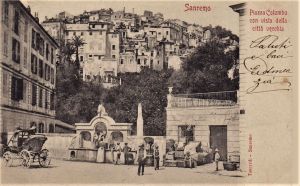 Part of the water from above flowed sideways into two niches on the lower sides to give dogs and cats the opportunity to drink.
Part of the water from above flowed sideways into two niches on the lower sides to give dogs and cats the opportunity to drink.
The head of a horse on the top of the arch of the fountain could mean that it was made for horses or refer to the creator Society.
(Free elaboration from different sources)
The fountain of Piazza San Siro
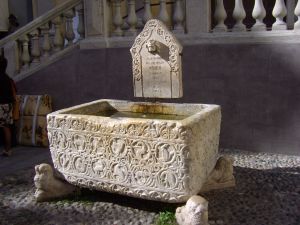 The tub is one of the most precious and least known objects of Sanremo, even if it does not belong to the ancient history of the city.
The tub is one of the most precious and least known objects of Sanremo, even if it does not belong to the ancient history of the city. 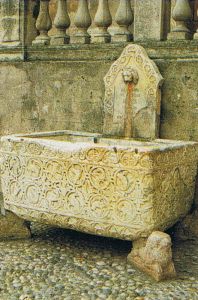 It was bought following an initiative of an English colonel, Momber, an officer of His British Majesty and resident in Sanremo, and of whom he had made a gift to the City in the early 1900s.
It was bought following an initiative of an English colonel, Momber, an officer of His British Majesty and resident in Sanremo, and of whom he had made a gift to the City in the early 1900s.
The following was written about him: «...Colonel Momber, a retired British officer, who distinguished himself for his activities in favour of animals, as remembered by the stele placed by his friends in memory of the Byzantine fountain he used as a drinking trough for horses, which is still located in Piazza San Siro...» (Taken from "Il Viaggio in Riviera" Daniela Gandolfi). He was also the founder of the Society for the Protection of Animals.
In reality, apart from the lions supporting the commemorative plaque, a recent creation, the basin of the fountain in question, which was in fact used as a drinking trough for horses, is an exceptional object: note the quality of the decorative relief in continuous webbing, which encloses an uninterrupted series of clipei in which many kinds of animals, each one different from the other, are housed.
It is a work rich in references to the Byzantine and Adriatic spheres, even though it is made of white Carrara marble. Few similar sculptural examples can be found in St Mark's in Venice or at Pomposa Abbey, also on the Adriatic coast.
It is therefore from that region, perhaps from the area of Aquileia, that this very precious object comes. It can be dated to the 12th century and its original function is still in doubt, as it could have been a sarcophagus or a baptismal font.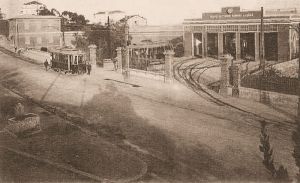 It was originally placed at the Foce, at the intersection of Via Legnano and Corso Matuzia, in the small garden where the newspaper kiosk is now located and right in front of the old Rimessa dei tram, but it was later moved and completely ignored.
It was originally placed at the Foce, at the intersection of Via Legnano and Corso Matuzia, in the small garden where the newspaper kiosk is now located and right in front of the old Rimessa dei tram, but it was later moved and completely ignored. 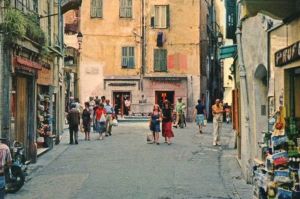 On Carlo Alberto's initiative, with a contribution from the Tourist Board, it was saved from abandonment and first placed in Via Corradi (in 1974).
On Carlo Alberto's initiative, with a contribution from the Tourist Board, it was saved from abandonment and first placed in Via Corradi (in 1974).
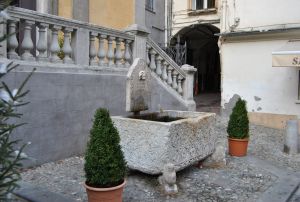
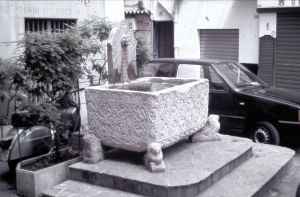 Later on, thanks to the interest and initiative of the FAI, it was placed in Piazza San Siro in front of the Oratory of the Immacolata, in the middle of the two access staircases.
Later on, thanks to the interest and initiative of the FAI, it was placed in Piazza San Siro in front of the Oratory of the Immacolata, in the middle of the two access staircases.
But in San Remo there was a second, very similar fountain, abandoned and badly damaged by neglect, which for years stood between two pine trees on the pavement by the sea, at 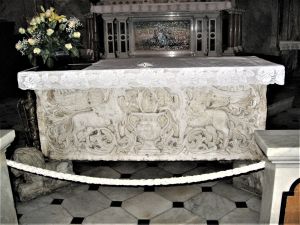 the beginning of Via Nino Bixio on the side of the old station, until the 1980s.
the beginning of Via Nino Bixio on the side of the old station, until the 1980s. 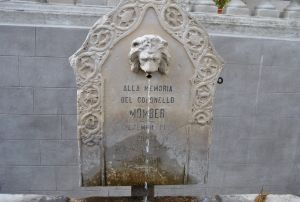 Don Cortona, parish priest of San Giuseppe, an art connoisseur, asked the municipality for permission to use it. He restored it himself under the guidance of the Sovrintendenza alle Belle Arti, and it is now the new altar of the Chiesa della Pigna.
Don Cortona, parish priest of San Giuseppe, an art connoisseur, asked the municipality for permission to use it. He restored it himself under the guidance of the Sovrintendenza alle Belle Arti, and it is now the new altar of the Chiesa della Pigna.
On the plaque above the Momber fountain, from which the water flows, an inscription reads: « to the memory of Colonel Momber, an example of kindness towards animals ».
(free elaboration from sources taken from various texts and authors; web and personal images)
The fountain in Piazza Cesare Battisti

 The fountain in Piazza Cesare Battisti (former railway station) was commissioned by Podestà Giovanni Guidi and designed by architect Silvio Gabbrielli in 1933.
The fountain in Piazza Cesare Battisti (former railway station) was commissioned by Podestà Giovanni Guidi and designed by architect Silvio Gabbrielli in 1933.
The bronze sculpture is the work of Florentine sculptor Sirio Tofanari.
 The peculiarity of this sculpture, which was intended by the commissioner to represent the coat of arms of Sanremo, is that it has two lions and not one, as is the case with the coat of arms granted to Sanremo, which is defined as follows: « In red with a natural palm tree, placed to the right of the shield and
The peculiarity of this sculpture, which was intended by the commissioner to represent the coat of arms of Sanremo, is that it has two lions and not one, as is the case with the coat of arms granted to Sanremo, which is defined as follows: « In red with a natural palm tree, placed to the right of the shield and  terraced in green, with a lion with a golden marquis crown on the left ».
terraced in green, with a lion with a golden marquis crown on the left ».
The official coat of arms was granted in 1928 by decree of the Head of Government and recorded in the register of the Consulta Araldica.
It seems that the coat of arms with two lions and a palm belongs to the Palmieri family.
(taken from a comment by Giacomo Mannisi on our FB Group)
Public wash houses and washerwomen
Even though the aqueduct commissioned by mayor Siro Andreea Carli provided the city with water, the problem of water for certain domestic needs remained the same. We are talking in particular about the washing and drying of household laundry.
Naturally, houses were not equipped with running water supply systems, so clothes had to be washed in streams or canals, and electric washing machines would see the light of day almost a century later. 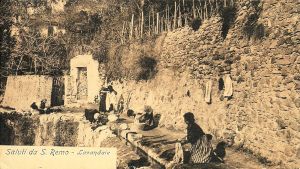 In those days, when it was not possible to do the washing at home (a "lescia" using ashes and boiling water) or in the riverbanks, given the inconvenience and difficulty of the work and also taking into account the fact that houses were poorly equipped to hang clothes such as sheets, bedspreads or other items out to dry, housewives, especially those who could afford it, preferred to pass on the task of doing the washing, at least in spring, to women who took it to the public wash-house. It was then the housewife's job to iron it with a charcoal iron.
In those days, when it was not possible to do the washing at home (a "lescia" using ashes and boiling water) or in the riverbanks, given the inconvenience and difficulty of the work and also taking into account the fact that houses were poorly equipped to hang clothes such as sheets, bedspreads or other items out to dry, housewives, especially those who could afford it, preferred to pass on the task of doing the washing, at least in spring, to women who took it to the public wash-house. It was then the housewife's job to iron it with a charcoal iron.
A category of specialised workers had thus been formed, who worked on behalf of third parties. "Les blanchiseuses", as a famous photographer called his photograph.
These laundresses used ancient, elaborate and laborious techniques, using boiling water, ash as a detergent, soda and Marseille soap.
Whenever possible, but often the professionals had to give it up, lavender or laurel was added to the washing water to perfume the clothes.
When rinsing the linen, "salda", a kind of dressing, was used, mixed with "turchinetto" to give the linen a light blue tint and facilitate the work on the garments to be ironed.
The public wash-houses were created specifically for these purposes, and consisted of one or more tubs with adjustable water, roofs for shelter from the sun and weather, and in some cases, drying racks.
These wash-houses were later set up by the community in various parts of the town. The ones we know of are those in Via Morado, San Costanzo, Porta San Giuseppe and Piazza Bresca.
As can be seen, the area best served was the Pigna.
The ancient district, penalised from the point of view of water and sanitation, found in the public wash-houses an indispensable contribution to the precarious hygienic balance of the time.
(text freely elaborated from various written sources)
Washhouse in via Morardo
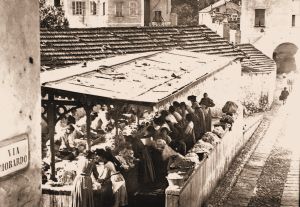
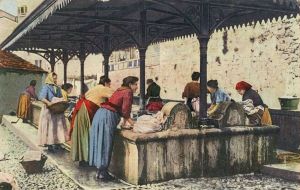 The strengthening of the aqueduct, built by the Siro Andrea Carli administration, facilitated the construction in 1831 of the first public wash-house in Sanremo, it seems on a small piece of land near the Market Square and along the right bank of the San Romolo stream.
The strengthening of the aqueduct, built by the Siro Andrea Carli administration, facilitated the construction in 1831 of the first public wash-house in Sanremo, it seems on a small piece of land near the Market Square and along the right bank of the San Romolo stream.
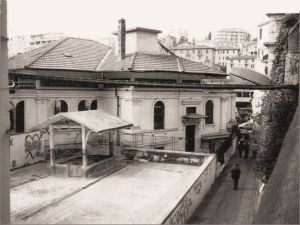 In 1875, in approving the construction of a public wash-house behind the Monastery of the Turchine in Via Morardo, it was established its water supply with the deviation of the waters coming from the fountains Capitolo, Palma and San Sebastiano.
In 1875, in approving the construction of a public wash-house behind the Monastery of the Turchine in Via Morardo, it was established its water supply with the deviation of the waters coming from the fountains Capitolo, Palma and San Sebastiano.
(free elaboration from various sources and authors)
Washhouse of Porta San Giuseppe
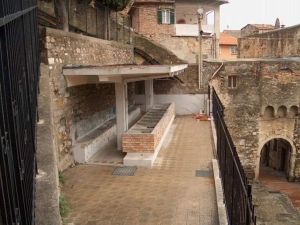
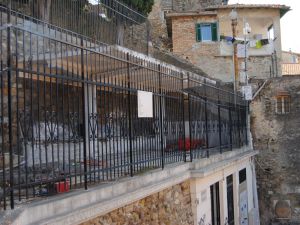 Of this wash-house we have very little information and even less pictures. The only images are the personal ones taken in 2010.
Of this wash-house we have very little information and even less pictures. The only images are the personal ones taken in 2010.
Washhouse in Bresca Square
By 1829, water from the Carli Aqueduct had already arrived to supply the city's various fountains, but it was not until 1834 that the fountain in Piazza dei Missionari (now Piazza 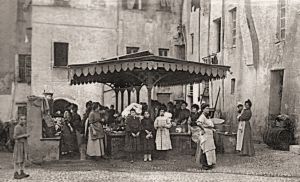 Bresca) was inaugurated, in order to meet the ever more pressing water demands of the densely populated marina district.
Bresca) was inaugurated, in order to meet the ever more pressing water demands of the densely populated marina district.
I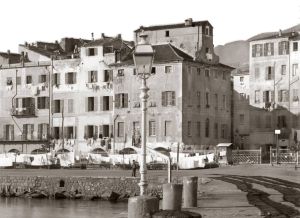 n the same period, for the same purpose, since there was no wash-house, one was inaugurated in Piazza dei MJissionari.
n the same period, for the same purpose, since there was no wash-house, one was inaugurated in Piazza dei MJissionari.
It was much frequented by the local washerwomen who, not having a suitable place to dry their clothes and linens, used the space in front of the harbour right in front of what was called the house of "Bacì Belu", which would later be demolished for the widening of Via Carlo Alberto (now Via Nino Bixio).
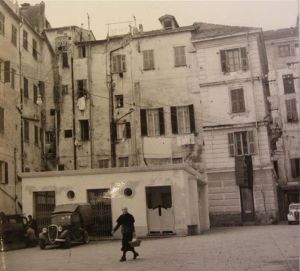 In the years around 1930 the original washhouse was demolished and a covered structure was built in its place, with washing tubs inside where housewives could go to wash their clothes.
In the years around 1930 the original washhouse was demolished and a covered structure was built in its place, with washing tubs inside where housewives could go to wash their clothes.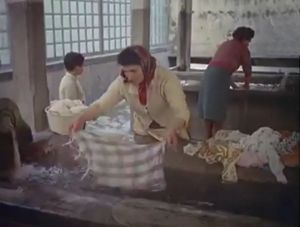
Washhouse of San Costanzo
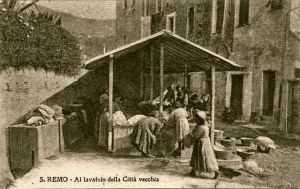 This wash-house, one of the first to be built, was originally at the exit of Via Tapoletti, next to the Oratory of San Costanzo.
This wash-house, one of the first to be built, was originally at the exit of Via Tapoletti, next to the Oratory of San Costanzo.
The earthquake of 23 February 1887 almost completely changed the face of the old town, with the demolition of many houses and the Oratory itself. The wash-house below was also affected.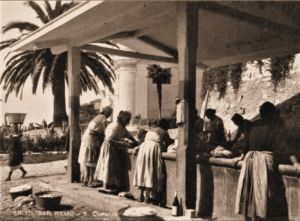
With the reconstruction of the religious building, with the façade facing west, the wash-house also changed its location, to the right of the façade, some thirty metres away.
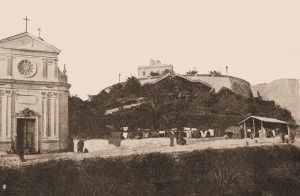 Clothes hung out to dry were leaning against the fence that overhung the supporting wall at their side. Today, of course, it no longer exists, like all the other wash-houses.
Clothes hung out to dry were leaning against the fence that overhung the supporting wall at their side. Today, of course, it no longer exists, like all the other wash-houses.
The Cisterns
What not everyone knows is that Sanremo, like other large cities, has its own little invisible city, underground.
These are: underground alleys; buildings incorporated under the paving of new squares; cisterns; wells in the cellars of the palaces.
In the upper part of the city (la Pigna), water from underground aquifers or rainwater (rain, etc.) was stored in tanks scattered here and there, hence the various place names such as Via Cisterna, Vicolo Cisternin or "funtanassa" to which a collection tank was attached.
In the flat part of the town, the system of wells (which fetched water from the few aquifers in the subsoil or from meteoric sources) and cisterns, in which water supplies were kept in view of drought periods, was the only existing system, the only one that allowed water supply.
There are an unknown number of cisterns scattered around La Pigna, even family cisterns, i.e. some people had them in their own homes, and during recent excavations for the hydraulic renovation of the old town, some of these were found.
This part of the city, almost invisible and for many unknown, belongs to the cultural heritage of the community and is in danger of being forgotten, with the passage of time, without adequate documentation and valorisation.
Here we will examine some of the more or less famous or ignored ones.
The "Funtanassa" Cistern
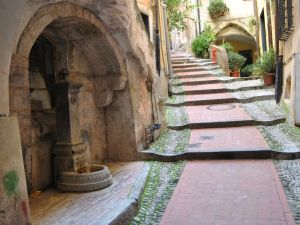
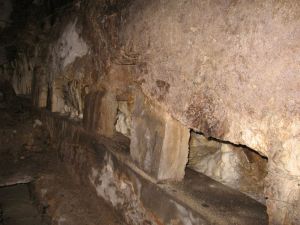 Among the oldest cisterns, mentioned in documents, there is certainly the one known as "a Funtanassa" (whose fountain we have already seen), enclosed within the circle of walls dating back to 1321; it opens onto Via Romolo Moreno, (once Via alla Costa) and since its origin has been fed by a small canal that collects water filtering from the ground and that can be seen at the back of the cistern.
Among the oldest cisterns, mentioned in documents, there is certainly the one known as "a Funtanassa" (whose fountain we have already seen), enclosed within the circle of walls dating back to 1321; it opens onto Via Romolo Moreno, (once Via alla Costa) and since its origin has been fed by a small canal that collects water filtering from the ground and that can be seen at the back of the cistern.
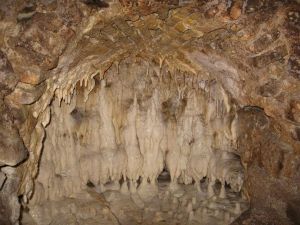
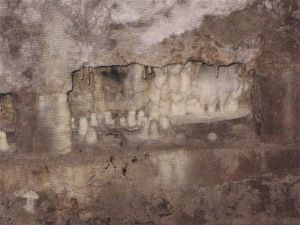 This trickle of water, which has a high limestone content, and the fact that it has not been altered over the years, has formed a number of small stalactites and stalagmites all along the gully and also a sort of tiny cave that makes the environment absolutely striking and spectacular.
This trickle of water, which has a high limestone content, and the fact that it has not been altered over the years, has formed a number of small stalactites and stalagmites all along the gully and also a sort of tiny cave that makes the environment absolutely striking and spectacular.
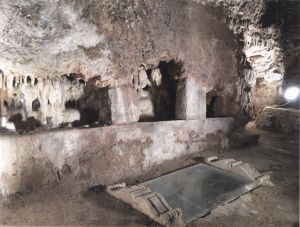 In the mid-1990s, the fountain, now unused and abandoned for a long time, the water being polluted due to the improper connection of the basin with
In the mid-1990s, the fountain, now unused and abandoned for a long time, the water being polluted due to the improper connection of the basin with 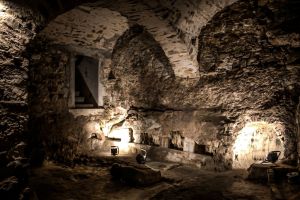 the sewerage pipe made in previous years, and therefore giving off an unpleasant smell, was purchased by a private individual.
the sewerage pipe made in previous years, and therefore giving off an unpleasant smell, was purchased by a private individual.
When he found it full of various types of waste, he patiently, and above all with the help of a tractor, emptied it and discovered the spring that fed the funtanassa.
This work brought to light many parts of the environment that had never been explored before, but above all the wall at the bottom of the cellar, as mentioned above, covered with stalactites and stalagmites.
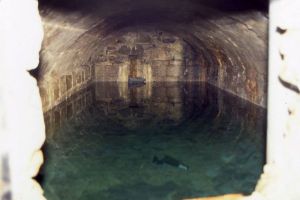 Now the water dripping from the wall is very pure and through a small channel it reaches the basin behind the fountain, from which it was fed.
Now the water dripping from the wall is very pure and through a small channel it reaches the basin behind the fountain, from which it was fed.
The interior of the fountain can today only be visited by appointment and only for guided tours.
The "Cisternin" Cistern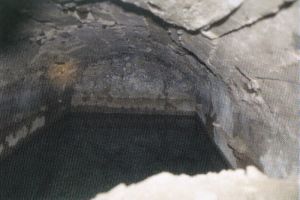
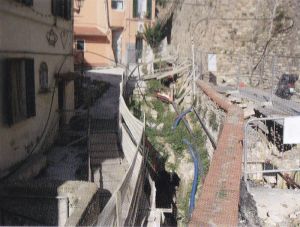 Another cistern, now known only by virtue of toponymy, has recently been identified; in the upper part of the town there is the alley Cisternin, which bears witness to the presence of a small cistern, the exact location of which unfortunately had been lost for many years.
Another cistern, now known only by virtue of toponymy, has recently been identified; in the upper part of the town there is the alley Cisternin, which bears witness to the presence of a small cistern, the exact location of which unfortunately had been lost for many years.
The Cisternin came to light while digging in the street of Porte Santa Maria during the works for the sanitation of the historical centre.
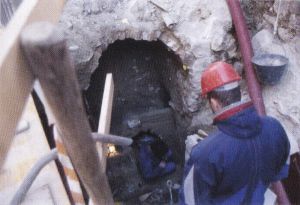 It has the same structure as the Funtanassa, a room with a barrel vault, the dimensions are similar, 5 x 2 metres, with the difference that the walls are in
It has the same structure as the Funtanassa, a room with a barrel vault, the dimensions are similar, 5 x 2 metres, with the difference that the walls are in 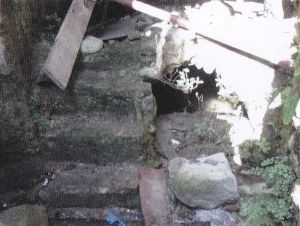 non-squared stone and this aspect, together with the fact that the upper part of La Pigna is the oldest part, leads us to hypothesise a date before 1400 for its construction.
non-squared stone and this aspect, together with the fact that the upper part of La Pigna is the oldest part, leads us to hypothesise a date before 1400 for its construction.
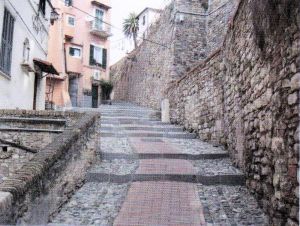 Unfortunately, after a thorough archaeological survey conducted by Claudio Mastrantuono (Cooperativa Dedalo) and the removal of the rubble obstructing it, the cisternin was once again encased under the road surface and cannot be visited by tourists.
Unfortunately, after a thorough archaeological survey conducted by Claudio Mastrantuono (Cooperativa Dedalo) and the removal of the rubble obstructing it, the cisternin was once again encased under the road surface and cannot be visited by tourists.
The tanks near the walls of San Giuseppe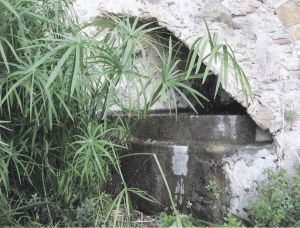
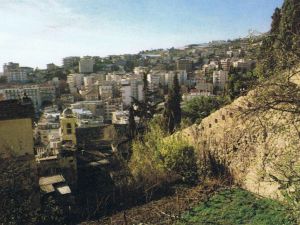 Other tanks for irrigation water are located near the 16th-century walls, which enclosed the town from the castle to the gates of San Giuseppe.
Other tanks for irrigation water are located near the 16th-century walls, which enclosed the town from the castle to the gates of San Giuseppe.
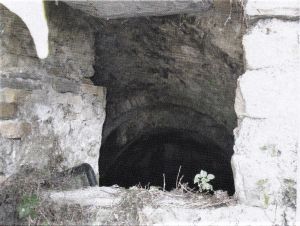
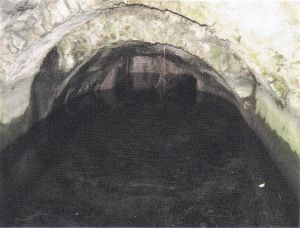
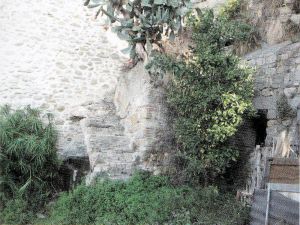
It is difficult to speculate on the period of their construction; fed by infiltration from an underground vein, they were used to water the vegetable gardens and gardens to the west of the 14th-century walls.
The cistern in Via Porte Santa Maria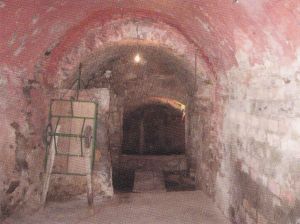
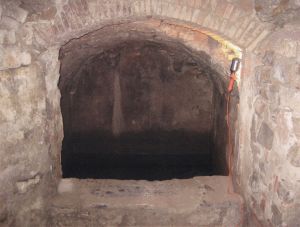 A cistern for private use is located at No. 18 Via Porte Santa Maria, positioned at the end of the cellar of which it is an integral part, also collecting water by infiltration.
A cistern for private use is located at No. 18 Via Porte Santa Maria, positioned at the end of the cellar of which it is an integral part, also collecting water by infiltration.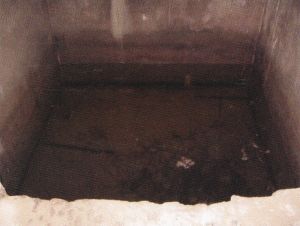
The cistern in Via Cisterna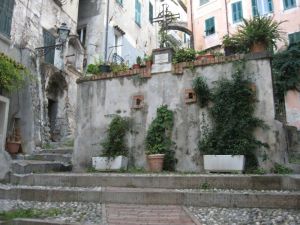
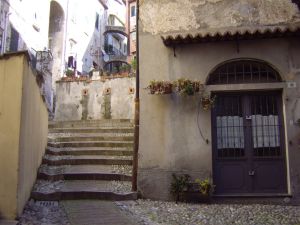 A resolution of the Sanremo parliament in 1607 granted the use of the Oratory of Santa Brigida to the brethren of Santa Brigida on condition that they use the funds at their disposal to build a large cistern to collect water for public use, especially useful in the summer period when drought and water needs were greatest.
A resolution of the Sanremo parliament in 1607 granted the use of the Oratory of Santa Brigida to the brethren of Santa Brigida on condition that they use the funds at their disposal to build a large cistern to collect water for public use, especially useful in the summer period when drought and water needs were greatest.
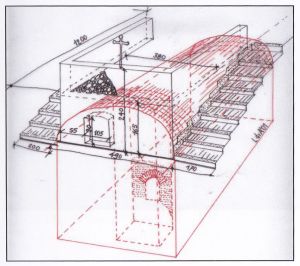
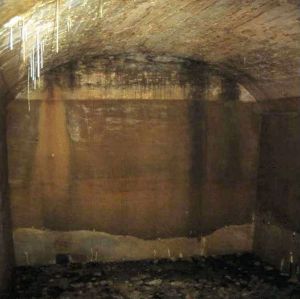 The cistern is of considerable size: a rectangular base structure measuring approximately 11 x 7 metres and a depth of around 7 metres, with a brick barrel vault; the walls are carefully plastered with hydraulic mortar for perfect waterproofing, and this does not allow, in the absence of further checks, to establish whether they are made of stone or also brick.
The cistern is of considerable size: a rectangular base structure measuring approximately 11 x 7 metres and a depth of around 7 metres, with a brick barrel vault; the walls are carefully plastered with hydraulic mortar for perfect waterproofing, and this does not allow, in the absence of further checks, to establish whether they are made of stone or also brick.
The small part of the floor that can still be seen, not having been covered by the rubble that has been introduced and which fills a large part of the cistern almost up to the impost of the vault, shows that it is covered with slate slabs.
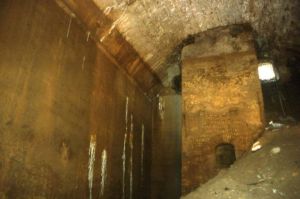 Rainwater was channelled into the cistern through a brick pipe, which is still visible at the top where the vault joins the wall.
Rainwater was channelled into the cistern through a brick pipe, which is still visible at the top where the vault joins the wall.
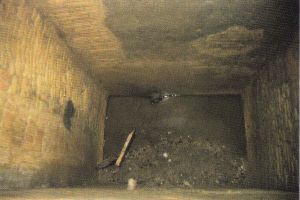 The peculiarity of this cistern, which differentiates it from all the others known, is the presence, inside it, of a brick structure of about 1.50 x 1 m, which, from the level of the pavement reaches the vault; one can only hypothesise its function, perhaps a decantation room for the water that, entering the cistern dirty, through rainwater collection channels, poured through a side opening into this sort of well, to be then taken clean from above.
The peculiarity of this cistern, which differentiates it from all the others known, is the presence, inside it, of a brick structure of about 1.50 x 1 m, which, from the level of the pavement reaches the vault; one can only hypothesise its function, perhaps a decantation room for the water that, entering the cistern dirty, through rainwater collection channels, poured through a side opening into this sort of well, to be then taken clean from above.
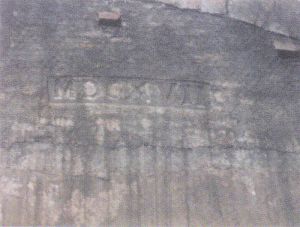
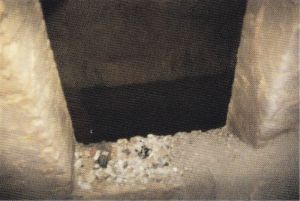 The date of construction of the cistern is written at the top of the back wall: MDCXVII.
The date of construction of the cistern is written at the top of the back wall: MDCXVII.
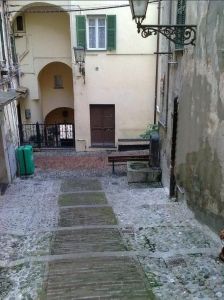 At the base of the street, almost at the crossroads with Via Palma, there has long been a fountain which is probably supplied directly from the cistern itself.
At the base of the street, almost at the crossroads with Via Palma, there has long been a fountain which is probably supplied directly from the cistern itself.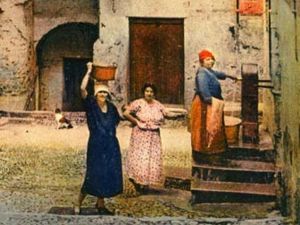
The cistern in Piazza A. Nota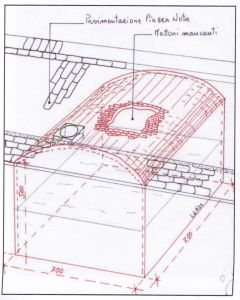
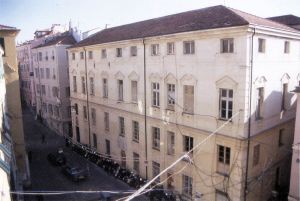 The cistern was built for the water needs of the building of the Palazzo del Commissario in 1750; it is slightly smaller than the cistern in via Cisterna, 7 x 7 m with a depth of 5 m, it is still half full, the water is clear, a sign that there is a continuous exchange, it is probably fed by an underground vein, just like other wells in the historic centre.
The cistern was built for the water needs of the building of the Palazzo del Commissario in 1750; it is slightly smaller than the cistern in via Cisterna, 7 x 7 m with a depth of 5 m, it is still half full, the water is clear, a sign that there is a continuous exchange, it is probably fed by an underground vein, just like other wells in the historic centre.
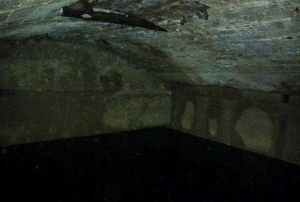
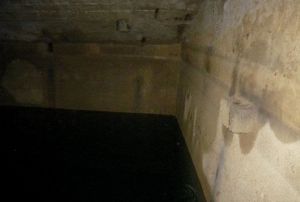 The lowered barrel vault of bricks has a hole in the centre, a clue that may suggest that there was a well above the cistern at that point, but an ancient drawing shows that the access to the cistern was located in the same place as the manhole cover from which the cistern can still be accessed; it is very likely that the hole in the vault was originally closed by an iron grille and was used to channel the water into the tank.
The lowered barrel vault of bricks has a hole in the centre, a clue that may suggest that there was a well above the cistern at that point, but an ancient drawing shows that the access to the cistern was located in the same place as the manhole cover from which the cistern can still be accessed; it is very likely that the hole in the vault was originally closed by an iron grille and was used to channel the water into the tank.
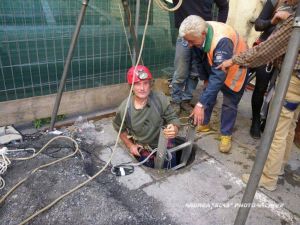
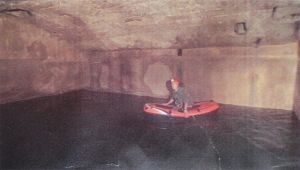 From the quick reconnaissance carried out, a small brick tube on one of the walls was noticed: considering that the maximum level marked by the water on the walls is exactly in correspondence with this tube, we can hypothesise that it could be the drain of the overflow or, alternatively, the channel that conveyed the water inside the cistern.
From the quick reconnaissance carried out, a small brick tube on one of the walls was noticed: considering that the maximum level marked by the water on the walls is exactly in correspondence with this tube, we can hypothesise that it could be the drain of the overflow or, alternatively, the channel that conveyed the water inside the cistern.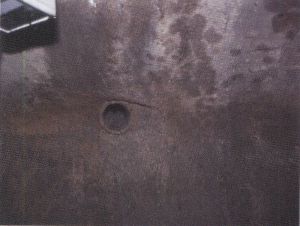
The Troughs
A number of cellars overlook Vicolo Vallai (the Vallum below Rivolte San Sebastiano). On the uphill side, those within the ancient circle of the 1321 walls, they all have the peculiarity of having tanks under the floor: the troughs.
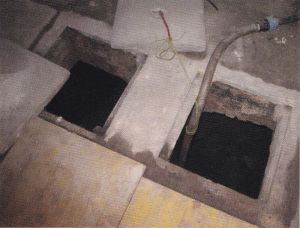
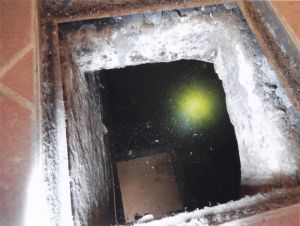 These basins, plastered with hydraulic mortar to make them waterproof, are called "tröji" in dialect (same origin as trou - hole in French); they were used on various occasions as silos for storing grain, as cisterns for oil or water, and as a food store in case of siege.
These basins, plastered with hydraulic mortar to make them waterproof, are called "tröji" in dialect (same origin as trou - hole in French); they were used on various occasions as silos for storing grain, as cisterns for oil or water, and as a food store in case of siege.
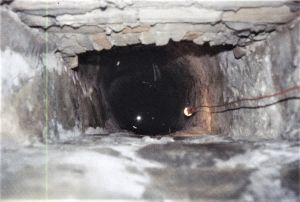 A fine well can still be seen at No. 3 Via del Pretorio, just behind the main door; the well could be accessed through an opening that allowed water to be drawn directly from inside the building; today this opening is closed and the niche houses the electricity meters.
A fine well can still be seen at No. 3 Via del Pretorio, just behind the main door; the well could be accessed through an opening that allowed water to be drawn directly from inside the building; today this opening is closed and the niche houses the electricity meters.
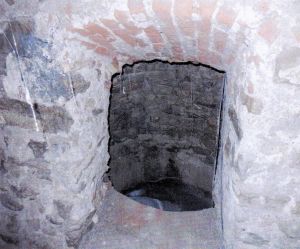 However, the well is still active, it is fed by an underground vein and fills up by infiltration; the water is drinkable, but for safety's sake, since it is not possible to carry out regular analyses, it is only used to water the garden.
However, the well is still active, it is fed by an underground vein and fills up by infiltration; the water is drinkable, but for safety's sake, since it is not possible to carry out regular analyses, it is only used to water the garden.
The water is drinkable, but for safety's sake it is only used for watering the garden as no regular tests can be carried out. It can be accessed from a cellar which has an entrance from Vicolo Vallai.
Another well, similar to the one in via del Pretorio, is located in a cellar of a house in via del Popolo.
(for the subject "The Cisterns", both the texts and part of the images are taken from "Sanremo Invisibile" by Giacomo Mannisi and Anna Blangetti, whom I thank for their collaboration; more images from private archives)





